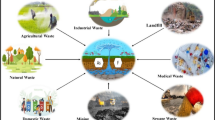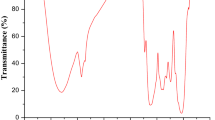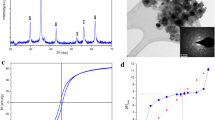Abstract
The present study aims to investigate the applicability of γ-Al2O3 nanoparticles (NPs) adsorbent for removal of arsenite and arsenate from aqueous solution. The nano-adsorbent was characterized using zeta potential analysis, dynamic light scattering, field emission scanning microscopy, energy-dispersive X-ray spectroscopy, Fourier transform infrared spectroscopy and X-ray diffraction. Batch adsorption studies were carried out to optimize adsorption parameters such as contact time, stirring speed, initial arsenic concentration, adsorbent dose, pH and effect of different competing anions. Langmuir adsorption capacities obtained at 298 K are 769.23 µg/g and 1000 µg/g for As(III) and As(V) removal correspondingly. The adsorption mechanism was well established by pseudo-second-order kinetic model. Negative values of enthalpy (ΔH°) obtained during adsorption [− 29.12 kJ/mol and − 35.55 kJ/mol for As(III) and As(V), respectively] confirmed the process was exothermic in nature. The negative values of ΔG° [− 6.14 to − 3.86 kJ/mol for As(III) and − 9.32 to − 6.68 kJ/mol for As(V)] further affirmed that the adsorption process is spontaneous in nature. There was no requirement of additional external energy supply for the enhanced removal as the adsorption was less favoured at high temperature. Phosphate and sulphate had the profound effect on reduction in the removal efficiency. Good regenerating efficiency of γ-Al2O3 NPs up to fourth cycle implied economic feasibility of the adsorbent. The effectiveness of γ-Al2O3 was also proved for removal of arsenic from real arsenic-contaminated groundwater.
Graphical abstract











Similar content being viewed by others
References
Al Hamouz OCS, Akintola OS (2017) Removal of lead and arsenic ions by a new series of aniline based polyamines. Process Saf Environ Prot 106:180–190
Allen SJ, Mckay G, Porter JF (2004) Adsorption isotherm models for basic dye adsorption by peat in single and binary component systems. J Colloid Interface Sci 280(2):322–333
Altundoğan HS, Altundoğan S, Tümen F, Bildik M (2002) Arsenic adsorption from aqueous solutions by activated red mud. Waste Manag 22(3):357–363
APHA (2012) Standards for examination of water and waste water, 22nd edn. American Public Health Association, America Water Works Association, Water Environment Federation, Washington
Bentahar Y, Hurel C, Draoui K, Khairoun S, Marmier N (2016) Adsorptive properties of Moroccan clays for the removal of arsenic(V) from aqueous solution. Appl Clay Sci 119:385–392
Bose P, Sharma A (2002) Role of iron in controlling speciation and mobilization of arsenic in subsurface environment. Water Res 36(19):4916–4926
Boyd GE, Adamson AW, Myers LS Jr (1947) The exchange adsorption of ions from aqueous solutions by organic zeolites. II. Kinetics1. J Am Chem Soc 69(11):2836–2848
Chakraborti D, Mukherjee SC, Pati S, Sengupta MK, Rahman MM, Chowdhury UK, Basu GK (2003) Arsenic groundwater contamination in Middle Ganga Plain, Bihar, India: a future danger? Environ Health Perspect 111(9):1194
Chakraborti D, Rahman MM, Chatterjee A, Das D, Das B, Nayak B, Sengupta MK (2016) Fate of over 480 million inhabitants living in arsenic and fluoride endemic Indian districts: magnitude, health, socio-economic effects and mitigation approaches. J Trace Elem Med Biol 38:33–45
Chakraborti D, Das B, Rahman MM, Nayak B, Pal A, Sengupta MK, Saha KC (2017) Arsenic in groundwater of the Kolkata Municipal Corporation (KMC), India: critical review and modes of mitigation. Chemosphere 180:437–447
Chaudhry SA, Ahmed M, Siddiqui SI, Ahmed S (2016) Fe(III)–Sn(IV) mixed binary oxide-coated sand preparation and its use for the removal of arsenite and arsenate from water: application of isotherm, kinetic and thermodynamics. J Mol Liq 224:431–441
Chen CJ, Wang SL, Chiou JM, Tseng CH, Chiou HY, Hsueh YM, Lai MS (2007) Arsenic and diabetes and hypertension in human populations: a review. Toxicol Appl Pharmacol 222(3):298–304
Chowdhury UK, Biswas BK, Chowdhury TR, Samanta G, Mandal BK, Basu GC, Roy S (2000) Groundwater arsenic contamination in Bangladesh and West Bengal, India. Environ Health Perspect 108(5):393
Dutta PK, Ray AK, Sharma VK, Millero FJ (2004) Adsorption of arsenate and arsenite on titanium dioxide suspensions. J Colloid Interface Sci 278(2):270–275
EPA (2000) Regulations on the disposal of arsenic residuals from drinking water treatment plants. Office of Research and Development, U.S. EPA (EPA/600/R-00/025). http://www.epa.gov/ORD/WebPubs/residuals/index.htm
Garelick H, Jones H, Dybowska A, Valsami-Jones E (2009) Arsenic pollution sources. In: Whitacre DM (ed) Reviews of environmental contamination, vol 197. Springer, New York, pp 17–60
Giles DE, Mohapatra M, Issa TB, Anand S, Singh P (2011) Iron and aluminium based adsorption strategies for removing arsenic from water. J Environ Manag 92(12):3011–3022
Goswami A, Raul PK, Purkait MK (2012) Arsenic adsorption using copper(II) oxide nanoparticles. Chem Eng Res Des 90(9):1387–1396
Hansen HK, Núñez P, Grandon R (2006) Electrocoagulation as a remediation tool for wastewaters containing arsenic. Miner Eng 19(5):521–524
Ho YS, McKay G (1998) The kinetics of sorption of basic dyes from aqueous solution by sphagnum moss peat. Can J Chem Eng 76(4):822–827
Inaba K, Haga M, Ueda K, Itoh A, Takemoto T, Yoshikawa H (2016) New adsorbent for removal of inorganic arsenic(III) from groundwater. Chem Lett 46(1):58–60
Khan TA, Chaudhry SA, Ali I (2013) Thermodynamic and kinetic studies of Arsenate removal from water by zirconium oxide-coated marine sand. Environ Sci Pollut Res 20(8):5425–5440
Kim Y, Kim C, Choi I, Rengaraj S, Yi J (2004) Arsenic removal using mesoporous alumina prepared via a templating method. Environ Sci Technol 38(3):924–931
Kim DH, Kim KW, Cho J (2006) Removal and transport mechanisms of arsenics in UF and NF membrane processes. J Water Health 4(2):215–223
Kumar E, Bhatnagar A, Kumar U, Sillanpää M (2011) Defluoridation from aqueous solutions by nano-alumina: characterization and sorption studies. J Hazard Mater 186(2):1042–1049
Lata S, Samadder SR (2016) Removal of arsenic from water using nano adsorbents and challenges: a review. J Environ Manag 166:387–406
Leupin OX, Hug SJ (2005) Oxidation and removal of arsenic(III) from aerated groundwater by filtration through sand and zero-valent iron. Water Res 39(9):1729–1740
Lin SH, Juang RS (2002) Heavy metal removal from water by sorption using surfactant-modified montmorillonite. J Hazard Mater 92(3):315–326
Lunge S, Singh S, Sinha A (2014) Magnetic iron oxide (Fe3O4) nanoparticles from tea waste for arsenic removal. J Magn Magn Mater 356:21–31
Mazumder DNG, Haque R, Ghosh N, De BK, Santra A, Chakraborti D, Smith AH (2000) Arsenic in drinking water and the prevalence of respiratory effects in West Bengal, India. Int J Epidemiol 29(6):1047–1052
Mukherjee SC, Rahman MM, Chowdhury UK, Sengupta MK, Lodh D, Chanda CR, Chakraborti D (2003) Neuropathy in arsenic toxicity from groundwater arsenic contamination in West Bengal, India. J Environ Sci Health, Part A 38(1):165–183
Mukherjee SC, Saha KC, Pati S, Dutta RN, Rahman MM, Sengupta MK, Nayak B (2005) Murshidabad—one of the nine groundwater arsenic-affected districts of West Bengal, India. Part II: dermatological, neurological, and obstetric findings. Clin Toxicol 43(7):835–848
Murcott S (2012) Arsenic contamination in the world. IWA Publishing, London
Nassar MY, Khatab M (2016) Cobalt ferrite nanoparticles via a template-free hydrothermal route as an efficient nano-adsorbent for potential textile dye removal. RSC Adv 6(83):79688–79705
Nassar MY, Mohamed TY, Ahmed IS, Samir I (2017) MgO nanostructure via a sol–gel combustion synthesis method using different fuels: an efficient nano-adsorbent for the removal of some anionic textile dyes. J Mol Liq 225:730–740
Naujokas MF, Anderson B, Ahsan H, Aposhian HV, Graziano JH, Thompson C, Suk WA (2013) The broad scope of health effects from chronic arsenic exposure: update on a worldwide public health problem. Environ Health Perspect 121(3):295
Ning RY (2002) Arsenic removal by reverse osmosis. Desalination 143(3):237–241
Owlad M, Aroua MK, Daud WAW, Baroutian S (2009) Removal of hexavalent chromium-contaminated water and wastewater: a review. Water Air Soil Pollut 200(1–4):59–77
Patra AK, Dutta A, Bhaumik A (2012) Self-assembled mesoporous γ-Al2O3 spherical nanoparticles and their efficiency for the removal of arsenic from water. J Hazard Mater 201:170–177
Ponder SM, Darab JG, Bucher J, Caulder D, Craig I, Davis L, Shuh DK (2001) Surface chemistry and electrochemistry of supported zerovalent iron nanoparticles in the remediation of aqueous metal contaminants. Chem Mater 13(2):479–486
Prabhakar R, Samadder SR (2018) Low cost and easy synthesis of aluminium oxide nanoparticles for arsenite removal from groundwater: a complete batch study. J Mol Liq 250:192–201
Rahman MM, Chowdhury UK, Mukherjee SC, Mondal BK, Paul K, Lodh D, Roy S (2001) Chronic arsenic toxicity in Bangladesh and West Bengal, India—a review and commentary. J Toxicol Clin Toxicol 39(7):683–700
Rahman MM, Ng JC, Naidu R (2009) Chronic exposure of arsenic via drinking water and its adverse health impacts on humans. Environ Geochem Health 31(1):189–200
Roy PK, Majumder A, Banerjee G, Roy MB, Pal S, Mazumdar A (2015) Removal of arsenic from drinking water using dual treatment process. Clean Technol Environ Policy 17(4):1065–1076
Sharma YC, Srivastava V, Singh VK, Kaul SN, Weng CH (2009) Nano-adsorbents for the removal of metallic pollutants from water and wastewater. Environ Technol 30(6):583–609
Smith AH, Lopipero PA, Bates MN, Steinmaus CM (2002) Arsenic epidemiology and drinking water standards. Science 296(5576):2145–2146
Temkin MJ, Pyzhev V (1940) Recent modifications to Langmuir isotherms. Acta Phys Chim Sin 12:217–222
Tofik AS, Taddesse AM, Tesfahun KT, Girma GG (2016) Fe–Al binary oxide nanosorbent: synthesis, characterization and phosphate sorption property. J Environ Chem Eng 4(2):2458–2468
Wang CH, Hsiao CK, Chen CL, Hsu LI, Chiou HY, Chen SY, Hsueh Y-M, Wu M-M, Chen CJ (2007) A review of the epidemiologic literature on the role of environmental arsenic exposure and cardiovascular diseases. Toxicol Appl Pharmacol 222(3):315–326
Weber TW, Chakravorti RK (1974) Pore and solid diffusion models for fixed-bed adsorbers. AIChE J 20(2):228–238
Weber WJ, Morris JC (1963) Kinetics of adsorption on carbon from solution. J Sanit Eng Div 89(2):31–60
Wen Z, Zhang Y, Dai C, Chen B, Guo S, Yu H, Wu D (2014) Synthesis of ordered mesoporous iron manganese bimetal oxides for arsenic removal from aqueous solutions. Microporous Mesoporous Mater 200:235–244
Zeldowitsch J (1934) The catalytic oxidation of carbon monoxide on manganese dioxide. Acta Physicochim URSS 1:364–449
Acknowledgements
The authors are sincerely grateful to the SERB-DST (Project No. SB/EMEQ-010/2014) for their financial support for the present research work. We would like to thank Department of ESE/IIT(ISM) Dhanbad, for providing all support needed. The authors would also like to acknowledge Indian Institute of Technology, Kharagpur, for allowing us to perform XRD analysis.
Author information
Authors and Affiliations
Corresponding author
Electronic supplementary material
Below is the link to the electronic supplementary material.
Rights and permissions
About this article
Cite this article
Ghosh, S., Prabhakar, R. & Samadder, S.R. Performance of γ-aluminium oxide nanoparticles for arsenic removal from groundwater. Clean Techn Environ Policy 21, 121–138 (2019). https://doi.org/10.1007/s10098-018-1622-3
Received:
Accepted:
Published:
Issue Date:
DOI: https://doi.org/10.1007/s10098-018-1622-3




